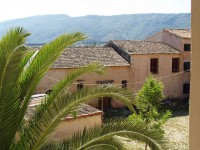Metochi Kalliteraki is located in the plain of Chania, about 3 km south of the city. A 270-acres land planted with olive trees, citrus fruits and avocado.
Metochi, and its buildings, is historically defined since the time of the Turkish domination (18th century) considered being part of the Red Metochi of the Venetian domination and part of the Aga’s daughter dowry. Around the 19th century, Metochi came to the possession of the Turk-Cretan Voskaki and in 1937 was bought by the Manouso and Niko Kalliteraki. To this day, it remains in the family. The farm was never included in the exchangeable properties in 1924 as its then wealthy owner Voskakis held a European citizenship besides the Turkish one. (After the Minor Asia destruction in 1922 a population exchange between Greece and Turkey took place. Many immigrants arrived in Crete, Greek Minor Asians, settled in the island and took parts of the Turkish Metochia. The only farms that did not lose any parts were those to which the owners held not only the Turkish citizenships, more commonly French, Italian or English. Most of these owners settled in Crete and seeked the opportunity of selling to the highest bidder. They were usually the richest, most Levantine, world travelled, educated and multi-ventured with the largest properties. Turk-Cretan Voskakis owned more than just this one Metochi in Crete as well as 70 properties in the commercial area of the old Chania harbor. He never actually lived in this Metochi but it was often occupied by caretakers, tenants.
During the Turkish domination the farm’s main cultivations aimed at its nutritional self-sufficiency, without excluding commercial purposes though. Therefore, olive tree cultivation expanded in a 190 acres olive groves area of the Tsounati variety, a variety dating back to the Venetian domination era. Citrus fruits, mainly tangerines, were also cultivated in an innovative for its time planting method. (This method comprises of constant distances between trees as to maximize production by planted area i.e. acres not by each tree as it was at the time). Citrus fruit farming dated back to the 19th century and at that time tangerines were a very expensive commodity therefore the farming area was enclosed by a 4m-high stone wall as to protect it by the elements and man. That same wall surrounds today 35 acres of citrus fruits.
The farm also has an 0,8-acre vine yard, horticultural products and grains to cover its own needs.
The farm also provided all kinds of fruit trees, fig trees, mulberries and practised sericulture and livestock-farming. There are also 3 big wells for the citrus and horticultural plantation (2 of which are still in working order today) and a smaller one to cover the needs of the building blocks.
During the 1950s the citrus fruits cultivation was expanded to the open fields, those that were not occupied by permanent multiannual cultivations and in the 1970s avocado farming followed and replaced-reformed part of the olive tree and citrus fruit areas. Today, avocado farming covers an area of more than 50 acres.
In 1996 avocado farming was included in the European program of biological farming and in early 2000 all of the farm’s production was enrolled and certified by the organisation DIO (http://www.dionet.gr) certificate of biological products program.
The farm in total is incorporated and participates in the local cooperative – Chania producers of biological products Group – to which allocates its crops (mainly avocado and citrus fruits) to trade in both Greek and European markets.
Since 2011, though initiative taken by some the farm’s heirs, the farm has stalls in open biological markets in the vicinity of Athens trading in avocado, olive oil and seasonal citrus fruits.









